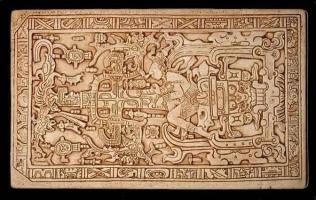Copy Link
Add to Bookmark
Report
dictyNews Volume 19 Number 13

Dicty News
Electronic Edition
Volume 19, number 13
December 7, 2002
Please submit abstracts of your papers as soon as they have been
accepted for publication by sending them to dicty@northwestern.edu.
Back issues of Dicty-News, the Dicty Reference database and other
useful information is available at DictyBase--http://dictybase.org.
=============
Abstracts
=============
ForC, a novel type of formin family protein lacking an FH1 domain, is
involved in multicellular development in Dictyostelium discoideum.
Chikako Kitayama and Taro Q.P. Uyeda
Journal of Cell Science, in press.
Summary
Formins are highly conserved regulators of cytoskeletal organization and
share three regions of homology: the FH1, FH2 and FH3 domains. Of the nine
known formin genes or pseudogenes carried by Dictyostelium, forC is novel
in that it lacks an FH1 domain. Mutant Dictyostelium lacking forC (forC)
grew normally during the vegetative phase and, when starved, migrated
normally and formed tight aggregates. Subsequently, however, forC cells
made aberrant fruiting bodies with short stalks and sori that remained
unlifted. forC aggregates were also unable to migrate as slugs, suggesting
forC is involved in mediating cell movement during multicellular stages of
Dictyostelium development. Consistent with this idea, expression of forC
was increased significantly in aggregates of wild type cells. GFP-ForC
expressed in forC cells was localized at the crowns, which are
macropinocytotic structures rich in F-actin, suggesting that, like other
formin isoforms, ForC functions in close relation with the actin
cytoskeleton. Truncation analysis of GFP-ForC revealed that the FH3 domain
is required for ForC localization; moreover, localization of a truncated
GFP-ForC mutant at the site of contacts between cells on substrates and
along the cortex of cells within a multicellular culminant suggests that
ForC is involved in the local actin cytoskeletal reorganization mediating
cell-cell adhesion.
submitted by: c.kitayama@aist.go.jp
-----------------------------------------------------------------------------
Title:
Myosin II contributes to the posterior contraction and the anterior extension
during the retraction phase in migrating Dictyostelium cells.
Authors name:
Kazuhiko S. K. Uchida, Toshiko Kitanishi-Yumura, and Shigehiko Yumura*
Adress:
Department of Biology, Faculty of Science, Yamaguchi University, Yamaguchi
753-8512, Japan
*Author for correspondence
Journal of Cell Science, in press
Abstract:
Cells must exert force against the substrate to migrate. We examined
the vectors (both the direction and the magnitude) of the traction force
generated by Dictyostelium cells, using an improved non-wrinkling silicone
substrate. During migration, the cells showed two 'alternate' phases of
locomotory behavior, an extension phase and a retraction phase. In accordance
with these phases, two alternate patterns were identified in the traction
force. During the extension phase, the cell exerted 'pulling force' toward
the cell body in the anterior and the posterior regions and 'pushing force'
in the side of the cell (pattern1). During the retraction phase, the cell
exerted 'pushing force' in the anterior region, while the force disappeared
in the side and the posterior regions of the cell (pattern2). Myosin II
heavy chain null cells showed a single pattern in their traction force
comparable to the 'pattern1', although they still had the alternate biphasic
locomotory behavior similar to the wild type cells. Therefore, the generation
of 'pushing force' in the anterior and the cancellation of the traction force
in the side and the posterior during the retraction phase were deficient in
myosin knock-out mutant cells, suggesting that these activities depend on
myosin II via the posterior contraction. Considering all these results, we
hypothesized the highly coordinated, biphasic mechanism of cell migration
in Dictyostelium.
submitted by: Uchida Kazuhiko [c2385@sty.cc.yamaguchi-u.ac.jp]
-----------------------------------------------------------------------------
Involvement of A Novel Gene, zyg1, in Zygote Formation of Dictyostelium
mucoroides
Aiko Amagai
Department of Developmental Biology and Neurosciences, Graduate School of
Life Sciences, Tohoku University, Aoba, Sendai 980-8578, Japan
Journal of Muscle Research and Cell Motility, Special Issue : Dictyostlium
Ed. Dietmar J. Manstein, in press
A gene, zyg1, was isolated by differential screening from Dictyostelium
mucoroides 7 (Dm7) cells, as one preferentially expressed during their
sexual development. The zyg1 gene encodes for a novel protein (ZYG1;
deduced Mr 29.4 x 103 ) consisting of 268 amino acids. Although the ZYG1
protein has predicted PKC phosphorylation sites, it has neither
transmenbrane domains nor specified signal sequences. The expression of
zyg1 was initiated after 2 h of starvation and reached its maximum level
at 8 h under submerged conditions. The expression pattern is quite similar
to the temporal change of zygote formation during sexual development
(macrocyst formation) with 1 h of precedence. The zyg1 mRNA in Dm7 cells
developed on agar was retained until zygotes were formed. Zyg1-
overexpressing cells derived from Dm7 cells eventually formed many loose
mounds, in which giant cells were surrounded by normal-sized cells, in
addition to mature macrocysts even under the conditions favouring for
asexual sorocarp formation. The giant cells were found by DAPI-staining
to be multinucleate, possibly because of the precocious overepxression of
zyg1 mRNA. Western blottings using a specific antibody raised against the
oligopeptide near the C-terminal region of ZYG1 also showed that ZYG1 was
actually over-produced in the zyg1-overexpressing cells. From these
results, it is evident that the zyg1 gene has an essential role in zygote
formation by inducing sexual cell fusion.
submitted by: Aiko Amagai [aiamagai@mail.cc.tohoku.ac.jp]
-----------------------------------------------------------------------------
[End Dicty News, volume 19, number 13]


















